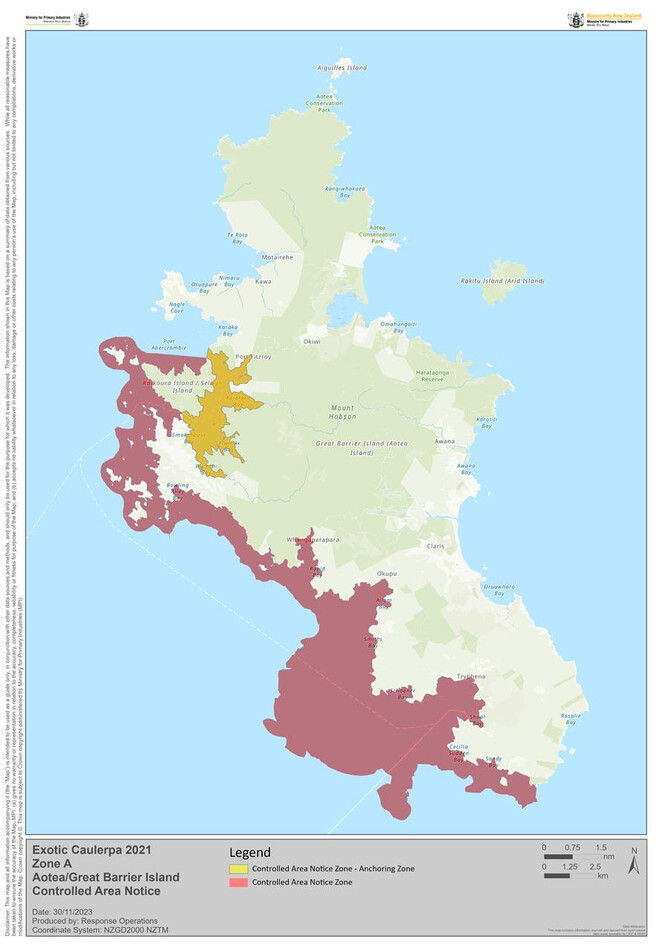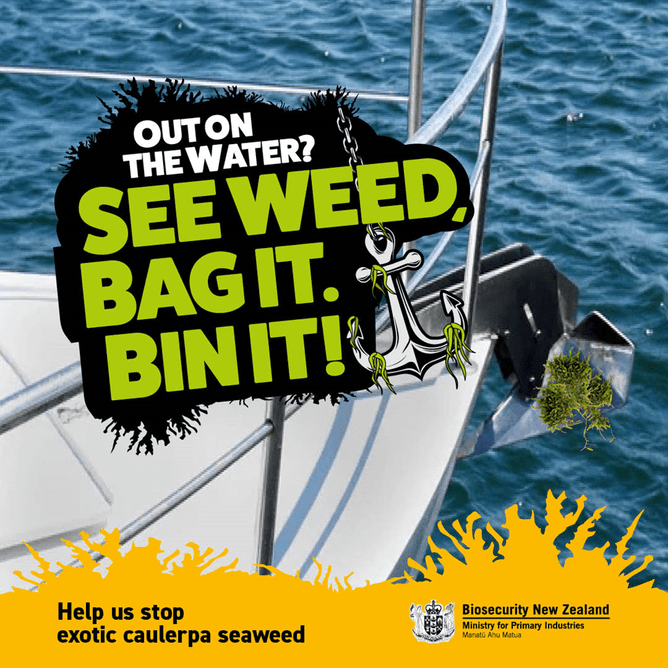Updated fishing and anchoring controls at Aotea in force from 1 December 2023
An updated Controlled Area Notice (CAN) comes into force (1 December 2023) for Aotea Great Barrier Island and Ahuahu Great Mercury Island, replacing the one which expires tonight.
In recent weeks there have been discussions with affected people from Mana Whenua, local authorities, the fishing industry and local communities about the most appropriate measures.
The update to the CAN reflects those discussions and manages the risk of human spread of caulerpa, while minimising the impacts on local people as much as possible. Readers of this newsletter will be aware there has also been a rāhui in place covering the three originally infested bays at Aotea. It is likely Mana Whenua and Kaumatua will review this in light of the CAN changes.
For Aotea Great Barrier Island, the new CAN includes:
An extended controlled area further north to encompass infested areas (see map below)
Anchoring restrictions will remain, with anchoring prohibited in the controlled area unless in an emergency or with a permit from Biosecurity New Zealand
However, there is a new permit-exempt area at Port Fitzroy
Less risky forms of fishing that don’t come into contact with the seabed, for example drift fishing from a boat or kayak, spear fishing, shore-based long-lining (e.g. using a kontiki or drone) and line fishing will be permitted.
Methods that come into contact with the sea floor such as set netting and dredging will remain prohibited.
The geographical area under control at Ahuahu Great Mercury remains the same, but the changes made to fishing methods at Aotea Great Barrier Island also apply here.
The new controls are in force until 30 June 2024.
Anyone planning boating or fishing at Aotea or Ahuahu this summer can visit www.biosecurity.govt.nz/caulerpa for precise boundaries and maps of the zones and actions required.
The existing Controlled Area Notice for Te Rāwhiti Inlet in Northland remains in place with the specific requirements unchanged until it expires at the end of June 2024. The updated Aotea/Ahuahu CAN is also in force until June 2024. All controls will be reviewed at this time to ensure they’re still fit for purpose.
Small piece of exotic caulerpa found at Medlands Beach, Aotea Great Barrier Island
There has been a detection of exotic caulerpa at a new location at Aotea Great Barrier Island.
A small fragment of suspected caulerpa was found near Memory Rock at Medlands Beach on the island's east coast by an Auckland Council staff member on Thursday last week.
A photo of the seaweed was sent to NIWA’s Marine Invasives Taxonomy Service who have confirmed it as one of the two exotic caulerpa species that are present in the waters at Aotea.
Further searching of the beach by Auckland Council staff failed to turn up any other beach cast exotic caulerpa.
Auckland Council has also conducted some limited in-water surveillance in the area using a remote operated vehicle and made no further detection. We are considering the need for further surveillance. In the meantime, anybody in the area should keep their eyes peeled and if you see anything that looks like exotic caulerpa, note the location, take a photo if you can and call MPI on 0800 80 99 66.
New summer ad campaign to help stop the spread of exotic caulerpa
A new summer campaign launched this week to inform boaties, fishers and divers about the simple actions they need to take when at sea to avoid spreading caulerpa.
We know that exotic caulerpa is able travel short distances naturally as small pieces adrift in the water, but it is spread primarily by people, snared in boating and fishing gear.
For this reason, we’re asking boaties to check their anchor, anchor chain and any gear that’s been in the water before they move on to a different location.
If any seaweed is found attached this equipment, they must remove it and securely bag it or contain it and take it ashore for safe disposal on land – for example in a rubbish bin or compost.
The key is ‘securely’ containing it. Any seaweed removed from gear needs to be in a bag or container that stops it getting back into the water at a different location.
If this can’t be done, people are asked to return it to the waters it came from. There will already be exotic caulerpa below and putting it back in this area will not pose a significant risk of spread.


